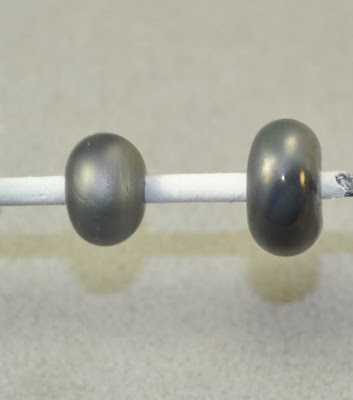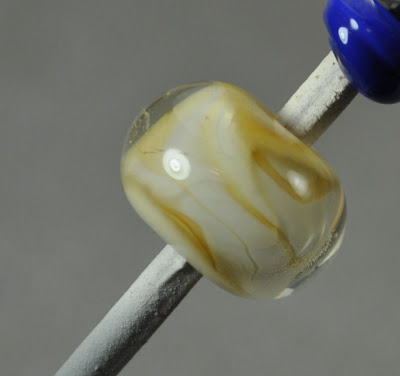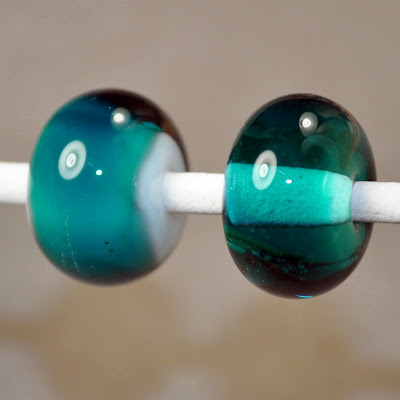
The ever present search for the ultimate black. Black is that exception to the rules - one of the oddities that we all love to explain to beginners: "These are the transparent glasses, and these are the opaque glasses. Oh, except for black - it's actually a really dark transparent." There's a mind-warping fact. The darkest colour of all it actually a transparent.

Along with "Why does my black spots on white bead have purple rings around them?" "Black does that - it's really a very dark transparent purple. If you want to use a real black, you have to use Intense Black." And so then your beginner discovers just how much Effetre Intense Black costs. There's another shocker!
So we save our Intense Black for special occasions - dots that must not be purpley. And we experiment with other blacks. Vetro Black - holds up MUCH better than Effetre Black. CiM Tuxedo. Not bad. Lauscha Black - about the same at Effetre. Oh - how about black striped over a dark opaque like dark lapis to make a true black stringer? Yep - there's that one too.
So what about
CiM Hades? CiM Hades is analogous to Effetre Intense Black - a true black, and, more expensive. But - Eff. Intense Black has some cool tricks up it's sleeve - that have not so much to do with colour as to do with the cool things you can make it do.
Intense Black bleeds and webs and melts out into fine tendrils - due to the high amount of colorant in the glass. To put it in technical terms: It goes all funky when you heat the snot out it.

And CiM Hades does the same. Maybe better.
These are three views of the same bead - this is very thin tendrils of CiM Hades on a very dark ivory (It might even be curdled ivory. So there. I still have some.)
Heat it until it is soupy hot - you will see the black start to spread and separate at the edges - the more it flows, the more it floats around - sending out tendrils.
Then just cool, shape, and do something with the ends - which are all pointy now that you have super-heated the bead. Instant Awesome! I totally adore this look!
OK - let's compare them head to head. Dark Ivory base - with a trail of Turquoise in the center (indicated in the image, as it reacted so strongly to the ivory it is hard to spot), and Hades on the left, and Intense Black on the right.
Equally cool, but noticeably different.

The Hades seems to have spawned more of the fine tendrils, but the Intense Black has pulled up more colour, separating the ivory out into light and dark, and rendering up a nice blue too.
I declare them equally awesome.

Just for fun - this is CiM Hades on Eff. Carnelian. I don't ever remember getting Carnelian to go this dark before - so did the more intense heat get it to strike darker, or did I burn it? Or is it a response to the black? I don't know. Especially as it is pinker in the middle.
The key to this black effect is heat. Give it lots of heat - you'll see it happen. Push the bead just a little farther than you intended and see what happens.















































